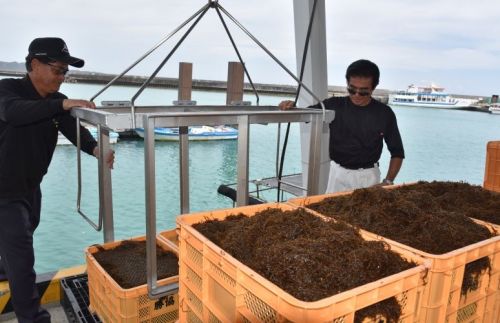Okinawan Mozuku, and edible seaweed, is struggling with poor harvests, leading to an increase in price and 6,000 ton decrease in production

Fishermen pulling mozuku out of the water at Katsuren Heshikiya Harbor. July 3, Uruma
July 4, 2019 Ryukyu Shimpo
By Erina Ishii
Due to a poor harvest of Okinawan mozuku in 2019, production totals have decreased by 6,000 tons from 2018 levels, and are expected to total around 15,000 tons.
It is believed to be caused by a combination of factors including climate factors such as a high water temperature and insufficient sunlight, as well as poor ocean conditions.
The Katsuren Fishery Cooperative Association (KFCA), the largest mozuku producer in Okinawa, increased the 2018 price-per-kilo for mozuku by 100 yen to 300 as a result of the poor harvest.
KFCA president Yuko Uehara said, “This is the first time in 20 years that the price has risen to 300 yen per kilo.”
The current period’s mozuku cultivation was low as crops did not replenish after an early harvest in the previous period (March). According to the Okinawa Fisheries Oceanography Research Center, during the mozuku growing period from November through December, the water temperature was about 2-4 degrees higher than the previous year at 26 degrees Celsius, reaching as high as 28 degrees on some days.
Mozuku grows best in water that is 25 degrees or lower, so it is thought that the higher water temperatures created unfavorable growing conditions.
The Katsuren region, which prices itself as Japan’s top mozuku grower, is projecting a mozuku yield of 5,000-6,000 tons for the current period.
For comparison, in 2018 the same period yielded 8,273 tons. KFCA president Uehara commented, “This year’s harvest is particularly poor compared to the previous year.”
The KFCA set per-kilo prices at 200 yen in March. Due to the poor harvest, the intermediaries that mozuku from fishermen set prices at 250 yen, so the KFCA raised prices to 300 yen. Uehara worried, “As a producer, a price over 150 yen is fine, but an increase of this amount will effect consumer prices.
If the price is high in the super market, consumers will stop purchasing it. Since mozuku is a mass-market item, it cannot be priced like a luxury.”
The Okinawa Fisheries Oceanography Research Center’s ocean resources and aquafarming division’s head researcher Shinobu Kondo said, “It is necessary to develop a strain of mozuku that will not experience crop instability even in warmer water.
We would like to find high grade plants out in the ocean, and develop a strain that we can offer to growers.”
(English translation by T&CT and Sam Grieb)
Previous Article:Kurara Chibana publishes her first anthology
Next Article:U.S. military again removes residents’ protest tents near Northern Training Area N1 zone gate
[Similar Articles]
- Mozuku aquaculture interrupted by pumice stones, expected to effect national supply
- Mozuku harvest begins in Miyakojima, yielding “thick, high quality seaweed, a prime result”
- Okinawa has had zero extremely hot days this year despite being so far south, why is this?
- Winter approaching in Okinawa as the temperature hits 15.7 C in Oku
- Processing of sugarcane starts – lowest output since Okinawa’s reversion
 Webcam(Kokusai Street)
Webcam(Kokusai Street)


